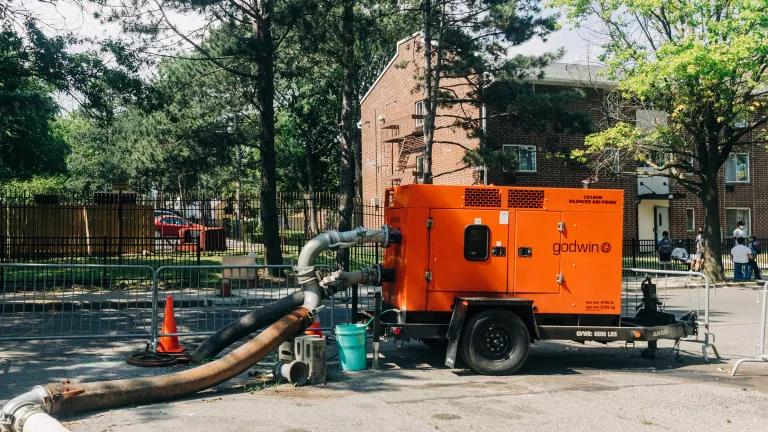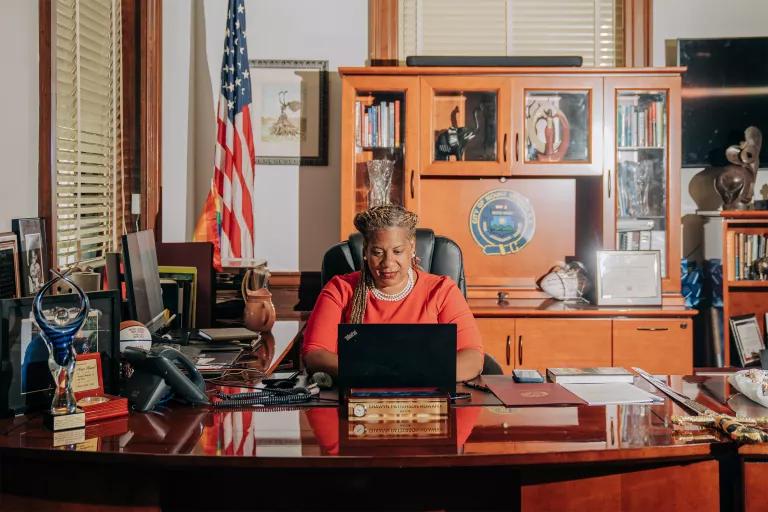Mount Vernon: Where Environmental Injustice Became a Sewage Nightmare
For decades, residents of this majority-Black suburb of New York City have been dealing with a noxious infrastructure crisis with little recourse. Finally, they’re getting some relief.

A sewage bypass pump installed in 2020 provides temporary relief for Mount Vernon residents as they wait for the city to upgrade the existing sewage infrastructure.
April 15 was the best day that Linda McNeil said she has had in 22 years. McNeil lives in Mount Vernon, New York, and over the course of those two decades, she has had to regularly battle floods of raw sewage in her basement. She’d wet-vac mess after mess as the nauseating stench of human waste would permeate her entire house. She wasn’t the only one. Since the turn of the century, the failing infrastructure in this city, which lies about a half-hour drive north of Manhattan, has caused sewage to overflow into thousands of homes. Even light rain or mild storms trigger the sewage backups. A lack of city funding and local political infighting contributed to decades of inaction on the crisis. McNeil eventually became one of the faces of Mount Vernon’s crisis, and in mid-April, she finally got the news she’d been hoping for. At a press conference, a teary-eyed McNeil said, “I just can’t believe this day is here.”
In an unprecedented partnership with Mount Vernon and Westchester County, Governor Kathy Hochul announced $150 million in funding to repair the city’s century-old clay pipes that had a habit of collapsing.
The offer is long-awaited relief to residents like McNeil, and it works to right an environmental injustice that’s been allowed to spiral for far too long. “Does anyone genuinely believe that what’s happening in Mount Vernon would be happening in one of the richer, predominantly white communities also in Westchester County, in the shadow of New York City?” asked NRDC Chief Counsel Mitchell Bernard and board member Catherine Coleman Flowers in a 2021 New York Times op-ed. About 62 percent of Mount Vernon, a city of roughly 68,000, is Black. By comparison, the whole of Westchester County’s population is around 17 percent Black.

The majority of backups occur on the city’s more densely populated south side, sapping enormous amounts of the residents’ time, energy, and money and taking huge tolls on their physical and mental health. McNeil has been open about her persistent headaches and loss of appetite, depression, and lack of sleep. And although the city’s Department of Public Works has been working tirelessly to fix the backups and help homeowners, the sheer magnitude of the problem is overwhelming. DPW Commissioner Damani Bush says it’s like playing a never-ending game of Whac-A-Mole, and during the new funding’s announcement, Mount Vernon Mayor Shawyn Patterson-Howard said, “When you’re dealing with a Herculean challenge, you need resources at a Herculean level to address it.”
In 2021, NRDC joined the vast effort to help shine a light on the issue and secure the necessary funding to fix it. Previously, the conversation around the overtaxed, failing infrastructure revolved solely around sewage discharge into the Bronx and Hutchinson rivers. For instance, the federal government continues to fine Mount Vernon $10,000 every day for related Clean Water Act violations pertaining to the contamination of the rivers, but there are no equivalent federal protections for the contamination of peoples’ homes. After Bernard and Flowers visited Mount Vernon last year, they began drawing attention to the human side of the sanitation problem. (Flowers has been a leading advocate on sewage issues in the South for more than 20 years.)

“It’s a really good example of the ways that our traditional environmental legal framework was not built to protect people first,” says Sahana Rao, a project attorney who is part of NRDC’s Environment, Equity & Justice Center. “A pretty significant theme in a lot of environmental justice work is the folks that created these laws are not necessarily directly experiencing a lot of these issues.” So along with Rao, other members of NRDC’s New York regional team, including Mark Izeman and Rich Schrader, got to work researching the situation and figuring out how they could help Mount Vernon address its residents’ concerns.
The team, working alongside another environmental organization, the National Wildlife Federation (NWF), began emphasizing the importance and severity of the sewage issues with New York State officials. Izeman believes NRDC’s commitment to water issues and environmental justice fights in the region helped build necessary trust. “They had confidence in us that if we're highlighting this issue, it's a good issue to pay attention to,” he says. “And it gives them some assurance to know that NRDC is involved on the ground.”

Mayor Patterson-Howard deserves the credit for nurturing connections with county and state officials, and ensuring the city received these funds. “Honestly, she is the MVP in all of this. The mayor had such a clear vision of what the city needed,” says Rao. “She was just tirelessly working to make sure it happened.” Bush can also attest to her dedication. He remembers Patterson-Howard joining him and his crew on the streets before dawn for a sewage line emergency.
Flowers agrees. “Usually when we go into communities, local elected officials are afraid or don't have the desire to dig deep into these issues because they’re afraid of backlash,” she says. “But the mayor did not do that here—she actually got help. The citizens exposed what was going on, the mayor became their champion—and the governor joined her.”
Patterson-Howard noted a similar dynamic with NRDC and NWF. Typically, such organizations would be on the side of government compliance agencies, she said. “But NRDC and NWF came to partner with us, as opposed to working against us.”
The path ahead
An overhaul of the city’s sewage system will take at least seven years to complete, but Governor Hochul directed an immediate $7 million toward restoring service on Third Street, one of the worst-hit areas, where residents currently rely on a makeshift system of temporary pumps. Another $8 million will fund other emergency repairs, and $3 million is earmarked for a pilot program to help families with home repairs related to sewage backups. The priority will soon shift to ensuring the DPW has the resources to quickly address the city’s sewage backups. Bush says that engineers will also create the first-ever bird’s-eye scan of Mount Vernon’s entire sewer system to see where the biggest problems are—and to smash that game of Whac-A-Mole once and for all. “Right now, we're trying to just solve one problem and then going to the next,” he says. “The engineers will help us develop a comprehensive plan on what we need to address that will help us allocate the $150 million in a cost-effective way.” NRDC’s team hopes to assist with that process.

The mayor hopes that the sewage system upgrade will also bring new prosperity to Mount Vernon. “The number of jobs that will be created by these investments is going to be paramount to the economic success of this community,” she said at the press conference. “We’re not just talking about money but job training opportunities, so that we can hire locals and reinvest in the community.”

Indeed, this development is a reminder that improvements in infrastructure—a word that gets thrown around quite a lot—do have very real, positive impacts on people’s daily lives. Bush hopes that the partnership in Mount Vernon can serve as a model for infrastructure agreements across the country. “This shows we can get it right—if we all just work together.”
This NRDC.org story is available for online republication by news media outlets or nonprofits under these conditions: The writer(s) must be credited with a byline; you must note prominently that the story was originally published by NRDC.org and link to the original; the story cannot be edited (beyond simple things such as grammar); you can’t resell the story in any form or grant republishing rights to other outlets; you can’t republish our material wholesale or automatically—you need to select stories individually; you can’t republish the photos or graphics on our site without specific permission; you should drop us a note to let us know when you’ve used one of our stories.


After Decades, Tenants Are Still Fighting NYC Public Housing for Speedy Mold Relief
Water Is Life—from Standing Rock to Oaxaca’s Mixtecan Highlands
How Rikers Island Became a Vehicle for Justice (Once It Started Shutting Down)